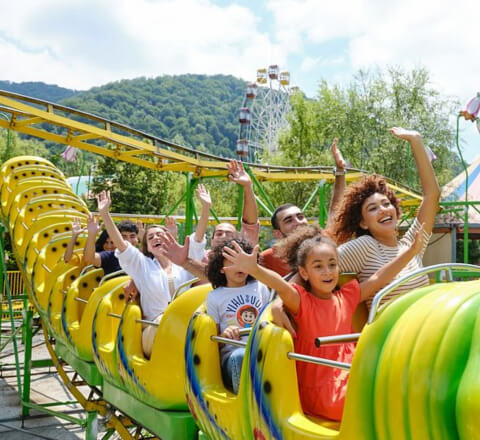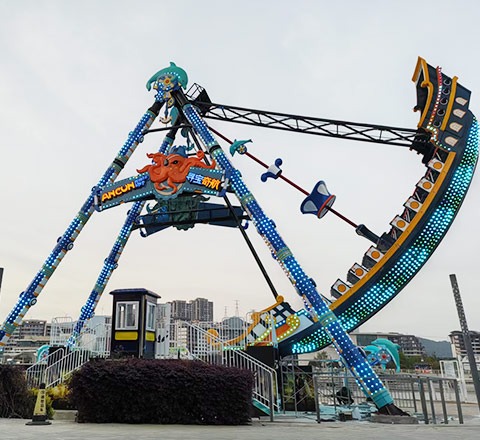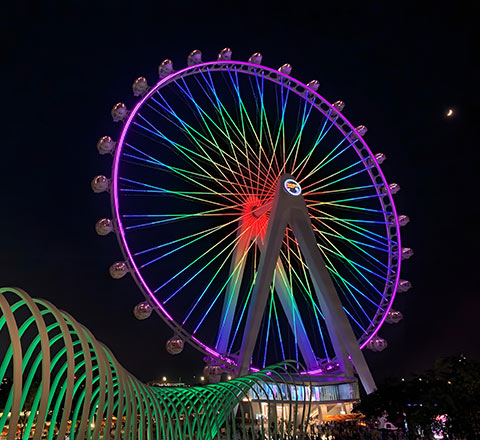
Las montañas rusas de madera están entre las más emblemáticas. tipos de atracciones de parques de atracciones, conocidos por su encanto nostálgico y su experiencia emocionante y traqueteante. Pero entre bastidores, mantenimiento de montañas rusas de madera es una de las tareas más exigentes del sector. A diferencia de las montañas rusas de acero, las estructuras de madera son muy vulnerables a la intemperie, la deformación y el desgaste natural. Un mantenimiento adecuado requiere más mano de obra, costes más elevados e inspecciones constantes, pero con el enfoque adecuado, estas atracciones pueden durar décadas.
Por qué es importante el mantenimiento de la montaña rusa de madera
La física de la madera hace que el mantenimiento sea mucho más complejo que el del acero. La madera se expande, se contrae y cambia de forma en función de las condiciones meteorológicas, creando desajustes que deben corregirse a diario. A diferencia del acero, los posavasos de madera no se construyen con piezas totalmente prefabricadas, lo que significa que los problemas de ajuste y alineación aparecen con más frecuencia.
¿El resultado? El mantenimiento de las montañas rusas de madera es mucho más caro que el de las de acero.-contrariamente al mito común de que "la madera es más barata". Por ejemplo, la antigua montaña rusa de madera de Cedar Point Racha media costaría alrededor de $250.000 al año para mantenerun factor importante para su conversión final en un híbrido de acero.
Mantenimiento diario de la montaña rusa de madera
Todos los días antes de la apertura, un equipo especializado debe escalar la estructura y recorrer la pista para garantizar la seguridad. Las tareas incluyen:
- Comprobación de la alineación de las vías: detección de alabeos, tablas desplazadas o conexiones sueltas.
- Inspección de pernos y ataduras: apriete de las fijaciones a lo largo del marco.
- Estado de la madera: identificación de grietas, astillas o podredumbre causadas por la intemperie.
- Trenes y retenciones: garantizar la seguridad de las ruedas, las barras ventrales y los cinturones de seguridad.
- Limpieza y desbroceEliminación de residuos y secado para evitar la putrefacción.
Este trabajo diario hace que el mantenimiento de las montañas rusas de madera sea mucho más intensivo que el de las de acero, donde gran parte del trabajo se centra en comprobar sensores, frenos y sistemas de la atracción.
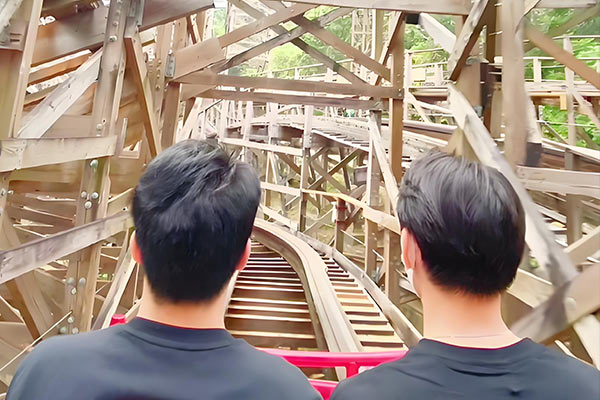
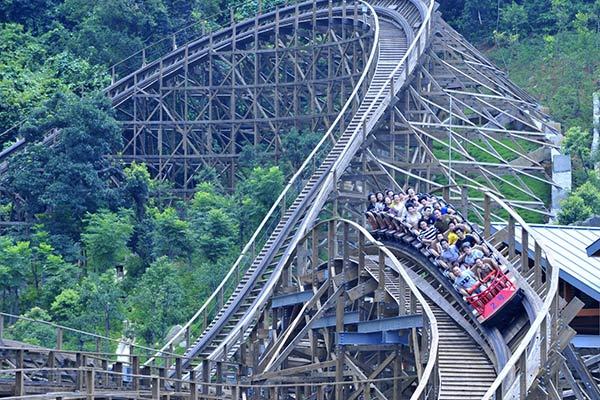
Mantenimiento semanal, mensual y estacional
Más allá de las rutinas diarias, las montañas rusas de madera requieren programas de inspección estructurados:
- Semanal: lubricación de sistemas mecánicos, comprobaciones de ruedas y pruebas de par de apriete de pernos.
- Mensualmenteinspecciones más detalladas de los soportes de madera y los puntos de tensión, que a menudo requieren una carpintería correctiva.
- Estacional/Anual: sustitución de tablas desgastadas, refuerzo de soportes y aplicación de revestimientos protectores contra la humedad y las plagas.
En cambio, las montañas rusas de acero suelen basarse en ensayos no destructivos (END)-como los rayos X y los ultrasonidos- para detectar grietas ocultas en las juntas soldadas. Aunque esta tecnología es costosa y requiere especialistas externos, requiere menos mano de obra que las inspecciones diarias de la madera.
Costes de mantenimiento: Madera vs Acero
La comparación de costes entre mantenimiento de montañas rusas de madera y mantenimiento de montañas rusas de acero es sorprendente:
| Categoría | Posavasos de madera | Posavasos de acero |
| Coste de construcción | $2-6 millones (según el tamaño) | $12 millones o más |
| Mantenimiento anual | Significativamente más alto, a veces $50.000 más que el acero | Menor coste de mano de obra, pero requiere costosas pruebas END y repintado |
| Necesidades laborales | Paseos diarios por las vías, apriete de pernos, sustitución de maderas | Menos trabajo diario, centrado en sensores, frenos e inspecciones |
| Longevidad | 70-80 años con un mantenimiento adecuado | 20-40 años, menor valor de reventa |
Mientras que los posavasos de acero requieren costosas inspecciones a cargo de contratistas especializados, los de madera exigen mano de obra interna constante y frecuentes sustituciones de material. Ambos conllevan costes elevados, pero de formas muy distintas.

Desafíos comunes en el mantenimiento de montañas rusas de madera
Los operadores de montañas rusas de madera se enfrentan a retos únicos:
- Impacto meteorológicoLa lluvia, la nieve y la humedad aceleran el deterioro de la madera.
- Reivindicaciones laborales: las caminatas diarias por las pistas requieren equipos numerosos y cualificados.
- Sustitución de material: las tablas, los soportes y las juntas deben cambiarse con regularidad.
- Ruido y vibraciones: aunque forman parte del encanto de la atracción, son señales de puntos de tensión que requieren vigilancia.
A pesar de las dificultades, muchos parques siguen invirtiendo en posavasos de madera por su atractivo nostálgico y su valor comercial.
Valor a largo plazo y asistencia del fabricante
En mantenimiento de montañas rusas de madera es más exigente, también soporta una vida útil más larga cuando se hace correctamente. Muchos posavasos de madera funcionan mucho más allá de su 70 aniversario, lo que les confiere un valor cultural e histórico incomparable con el acero.
Por eso, la elección del fabricante de montañas rusas asuntos. En Paseos en CARNEEno sólo proporcionamos montañas rusas en venta-también suministramos guías de mantenimiento, piezas de repuesto, formación y asistencia a largo plazo. Con más de 20 años de experiencia en atracciones de feria, nuestro equipo ayuda a los parques a gestionar eficazmente el mantenimiento de las montañas rusas de madera y acero.
👉 Más información en nuestra Guía de mantenimiento de montañas rusas, Guía de mantenimiento de montañas rusas infantileso explore nuestra Guía de mantenimiento de atracciones.
Conclusión
Mantenimiento de montañas rusas de madera es exigente, laborioso y costoso, pero también es la clave para que estas atracciones clásicas sigan siendo seguras y emocionantes durante generaciones. En comparación con las montañas rusas de acero, las de madera requieren más atención diaria y trabajo de sustitución, pero recompensan a los operadores con longevidad y un atractivo único para los usuarios.
A la hora de decidir entre madera y acero, la elección no sólo tiene que ver con la experiencia de la atracción, sino también con el mantenimiento, los costes y el valor a largo plazo. Con el fabricante y el socio de mantenimiento adecuados, su montaña rusa puede ofrecer emociones seguras durante décadas.



